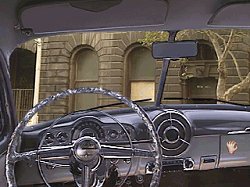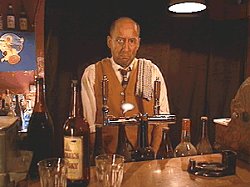|
The Dame Was Loaded
 It's nice to review a local product, even if the game is set nowhere near home. Featuring Australian actors, some who went on to become better known (at least down under), The Dame Was Loaded is a full motion video detective game set in the USA in the 1940s.
The main protagonist is Scott Anger. Like all noir-ish detectives he carries a wound from which he cannot escape. Surfacing recently from the bottom of a bottle, a mundane missing brother case seems like a good way to get things going again.
I myself recently surfaced from hunting for vampires, and I mention it only because this game shares with Dracula Unleashed a game mechanism that if I had never seen it again I would not have been upset. Seeing it again so soon was cause for mild panic. It's nice to review a local product, even if the game is set nowhere near home. Featuring Australian actors, some who went on to become better known (at least down under), The Dame Was Loaded is a full motion video detective game set in the USA in the 1940s.
The main protagonist is Scott Anger. Like all noir-ish detectives he carries a wound from which he cannot escape. Surfacing recently from the bottom of a bottle, a mundane missing brother case seems like a good way to get things going again.
I myself recently surfaced from hunting for vampires, and I mention it only because this game shares with Dracula Unleashed a game mechanism that if I had never seen it again I would not have been upset. Seeing it again so soon was cause for mild panic.
I refer to the fact that time is a key component of the game. Whilst real time might add something special to strategy games, it does nothing for adventure games when it prevents you from successfully completing the game. More than that, you usually aren't even aware that you have missed a key event until such time as time runs out and the game ends unsuccessfully.
At face value, real time might be seen as more natural. Clearly the world does not stand still waiting for you to come along. Perhaps also there is a view that with full motion video, real time better suits the reality of the game world. Yet the second Gabriel Knight game springs to mind as an excellent example of full motion video game play, and whilst some events needed time to advance, time passing was triggered by your character achieving the necessary objectives. There was nothing unnatural about the game play, and I suspect the fact that more recent games avoid a real time mechanism is testament to its unlike-ability, if not its unsuitability. Adventure players tend to like poking about and taking their time, rather than having time take them where it may.
 The passage of time in this game seems more forgiving than in other such games, and some events or actions are not essential to finish, but if other events pass you by then so will the game. You have three days to find the missing brother, and on the first occasion I survived the three days but as I had not found the brother, the game simply ended. Whilst I had "finished" the game, there was clearly much more to do; not only did I have to find the brother, but I had not even accessed the second of the two game CDs.
Several restarts from various periods didn't get me much further, but eventually I managed to achieve an extension of the three-day deadline, which gave me access to the next disk. To do so, though, I had to replay many sequences and events, not really knowing whether what I was doing would lead to success. I did not, in fact, know if there was a single key event, or whether a particular sequence of events was required. Too many road signs makes for dull playing, but I thought The Dame could have been a bit more explicit. There are some rather convoluted (and at times slightly obtuse) sequences.
There are apparently 9 different endings, depending upon what you do or don't do. I found 3, which was enough for me. The passage of time in this game seems more forgiving than in other such games, and some events or actions are not essential to finish, but if other events pass you by then so will the game. You have three days to find the missing brother, and on the first occasion I survived the three days but as I had not found the brother, the game simply ended. Whilst I had "finished" the game, there was clearly much more to do; not only did I have to find the brother, but I had not even accessed the second of the two game CDs.
Several restarts from various periods didn't get me much further, but eventually I managed to achieve an extension of the three-day deadline, which gave me access to the next disk. To do so, though, I had to replay many sequences and events, not really knowing whether what I was doing would lead to success. I did not, in fact, know if there was a single key event, or whether a particular sequence of events was required. Too many road signs makes for dull playing, but I thought The Dame could have been a bit more explicit. There are some rather convoluted (and at times slightly obtuse) sequences.
There are apparently 9 different endings, depending upon what you do or don't do. I found 3, which was enough for me.
Exacerbating the time aspect is the fact that you only have 5 save game slots. Given the need to reload and retrace your steps, trying different things at different times, this was way too few.
Scott has 3 inventories, one on his person, another in his office and one in the boot of his car. You may very well have to swap things between them as he can only carry so much. I didn't mind this but accessing the inventories is a pain, requiring both the left and right mouse buttons to be clicked at the same time.
The inventory menu also contains a notebook in which information is automatically recorded, a watch to keep track of the time and which can also be used to advance time, and a wallet. Scott will spend money, but must also acquire more. He can do this in a variety of ways, some less than legal.
Scott can talk to many characters, some of whom may have to be encouraged to talk. There are many ways to achieve this, each reasonably well connected to the character involved. A menu of conversation topics can be accessed for each conversation. Some necessary snooping will also require Scott to find ways to distract characters, or even get them to leave the room. But don't spend too long looking at things you shouldn't, and nor must you spend too long in certain sticky situations. Time is critical for certain situations, as well as overall.
 Whilst the game is full motion video, many of the screens will be still shots, and voice-overs will occur without a video sequence resulting. This is most usually when questioning another character - that character and the scene will be predominantly static throughout the interrogation, the game occasionally interspersing still close-ups or short video sequences.
Unlike many FMV games, the videos and game world scenes utilise the whole screen. It is a bit grainy and pixelly, but it is ok to watch and look at, though on occasion the need to discern fine detail can be difficult.
Icons will indicate something can be moved or examined, or that a conversation can occur, but you will not get an icon to indicate that an inventory item can be used. In that regard you are on your own.
Arrows will indicate you can move in a particular direction, but movement within scenes tends to be fairly limited. Movement between different locations is in Scott's car, utilising the map in the glove box on which new locations will appear as you learn more. Helpfully, Scott will often tell you if there is no point going to a particular location at this time, thereby saving you time of your own.
The character acting ranges from acceptable to poor. Typical of a product with this title, there are gangsters and card sharks (you will have to play a bit of poker so brush up on your rules), crooked cops and long legged women. Everyone seems just a little bit dirty, so finding the true villain(s) will take some doing. The plot does not rise to any great heights, but it does wriggle about and do its best to shake you off. Needless to say the missing brother is the just the start. Whilst the game is full motion video, many of the screens will be still shots, and voice-overs will occur without a video sequence resulting. This is most usually when questioning another character - that character and the scene will be predominantly static throughout the interrogation, the game occasionally interspersing still close-ups or short video sequences.
Unlike many FMV games, the videos and game world scenes utilise the whole screen. It is a bit grainy and pixelly, but it is ok to watch and look at, though on occasion the need to discern fine detail can be difficult.
Icons will indicate something can be moved or examined, or that a conversation can occur, but you will not get an icon to indicate that an inventory item can be used. In that regard you are on your own.
Arrows will indicate you can move in a particular direction, but movement within scenes tends to be fairly limited. Movement between different locations is in Scott's car, utilising the map in the glove box on which new locations will appear as you learn more. Helpfully, Scott will often tell you if there is no point going to a particular location at this time, thereby saving you time of your own.
The character acting ranges from acceptable to poor. Typical of a product with this title, there are gangsters and card sharks (you will have to play a bit of poker so brush up on your rules), crooked cops and long legged women. Everyone seems just a little bit dirty, so finding the true villain(s) will take some doing. The plot does not rise to any great heights, but it does wriggle about and do its best to shake you off. Needless to say the missing brother is the just the start.
The game is in DOS but will launch itself from the Windows directory. It ran fine on my P4 with no fiddling required, other than for sound. I had to configure the sound card within the install program, and could never get rid of an occasional choppiness. I also found that occasionally the game would launch without sound (probably a driver issue) and I would have to restart the computer.
There is some ambient noise, and fairly good use of background music. There are no subtitles.
In the end, the real time nature of the game prevented me from enjoying this outing. I decided early on to forget about time, and simply play as I normally would. Then when time ran out, I would review what I had done, and try a different path through the game. This got me through, but I saw a lot of the same parts over and over, every replay detracting from the overall experience.
Timed puzzles are anathema to many adventure players, and those same players will no doubt not look favourably on timed games. However there are undoubtedly players that do like this characteristic, and it certainly adds a different element to what is going on. I doubt though I will be hurrying to play another such game.
Copyright © Steve Ramsey 2003.
All rights reserved.
System Requirements:
486 DX 33, 8Mb RAM, CD ROM, 6 Mb disc space,
(Note - the DOS Operating System was not specified)
|

